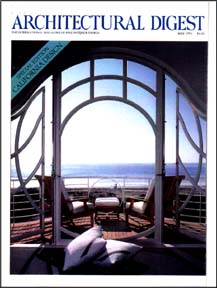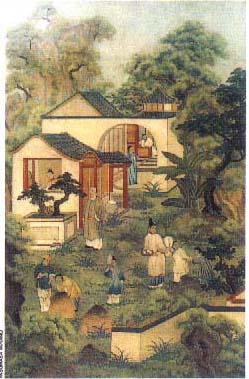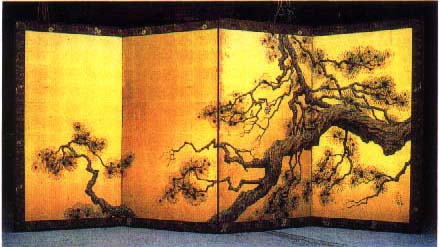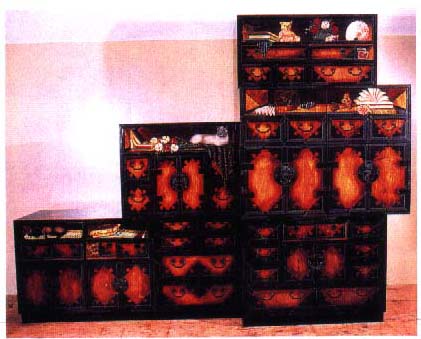|

WEST COAST DECORATIVE PAINTERS
Traditional Disciplines Applied with Contemporary Spirit
By Hunter Drohojowska
© Architectural Digest, May 1991
|
In
the rarefied world of contemporary art, the notion of the "decorative" often
meets with disdain. Yet before the modern era, decoration
was considered one
of the primary functions of painting. Embracing rather than
rejecting the styles and skills of the past, a handful of
artists in California have returned to decorative painting.
They have mastered Renaissance realism, trompe-l'oeil illusion
and Japanese naturalism while forging their own individual
styles.
Japanese
and Chinese arts have historically celebrated decoration,
and the influence of the Far East
is evident in the work of three of these painters. Wayne
SMyth says his attraction to Japanese art stems from that
culture's appreciation for harmony with nature. "The
|

ABOVE:
Robert Crowder of Los Angeles lived in Japan for many years
and studied with the painting master Mochizuki Shunko.
He has worked in the Oriental style for almost 50 years. Photo
by Yasumasa Tanano
|
Japanese
have the ability to improve on nature," he notes. "'More beautiful
than true,' as they would say."
Smyth
worked as an art director before turning to painting. Then in 1979
he was asked to do a pair of screens depicting a Japanese emperor
and empress for Linda Ronstadts's
house
in Malibu. They proved a success, and he started working in a Japanese
style on screens built by his partner, George Lazoraitis. Smyth
points out that in Japan the maker of screens, the hyogushi,
is as respected as the painter.

ABOVE: Wayne
Smyth's delicate composition in the Edo-period style is executed
on a four-panel screen made with traditional Japanese methods
by his partner, George Lazoraitis.
|
Lazoraitis builds each screen's framework
from tempered alder wood, covers it with seven layers of mulberry
paper, finishes the front with gold or silver leaf or silk,
and after the image is completed, adds a border of antique
Japanese Brocade and a black-laquered frame. The two artists,
who live in Los Angeles, operate under the name Byobu West
-- from the Japanese word for screen.
|
Smyth
is inspired by Edo-period art, and his screens feature scenes
such as cranes in flight or
evening rains. The effect is Japanese but scaled to meet
the requirements of a Western interior. "We give the client
a traditional subject but in untradtional sizes," explains
Smyth.
Robert
Crowder, also in Los Angeles, has been painting in the style
of the Far East since the
mid-1940s. Before the Second World War, Crowder was teaching
English and music in Tokyo. While there, he studied painting
with the Japanese master Mochizuki Shunko.
|

ABOVE:
Best known for her playful adaptations of the traditional Japanese tansu,
Karen Kariya uses her accomplished trompe-l'oeil technique
to create
the illusion of iron hardware and shelves, to which she often
adds a variety of the client's personal possessions.
|
|
Since
his return to this country after the war, he has dedicated
himself to painting, and his command of the Japanese style
is convincing: He was commissioned by Mitsui to decorated
the Japanese Pavilion at EPCOT Center in Florida.
The
Japanese aesthetic is understated and humorous in the work
of Karen Kariya. A third-generation
Japanese American, she counts nineteenth-century American
trompe-l'oeil artists Milliam Michael Harnett and John
Frederick Peto as important influences. She is best known
for her trompe-l'oeil tansu --
chests with touch-latch doors and clever illusions of shelves
and iron hardware. For commissioned works, Kariya will
personalize her pieces by using the owner's name in the titles
of books
she has depicted on the shelves. This sort of coded symbolism
is in keeping with the tradition of trompe-l'oeil. |
|
|